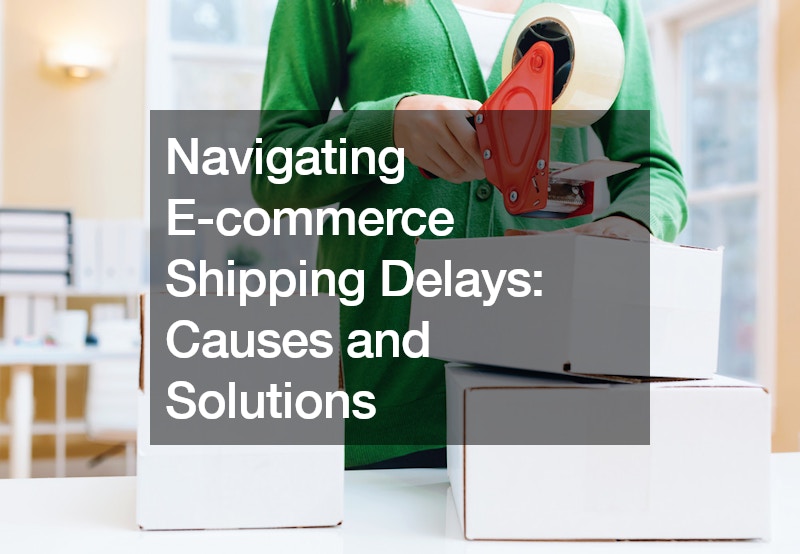If you’ve ever bought or sold something that needed to be shipped overseas, you’re no doubt familiar with the fact that a freight carrier could end up with delays. In such cases, most carriers may be aware of the issue that led to the delay, and this may lead to them sending messages like “severe weather conditions have delayed delivery.” They could also have notices in place, including “local delay beyond our control.” This saves them from ending up with countless messages all asking something like “why is shipping taking so long?” when they know what the issue is, and it happens to be beyond their control.

That said, before you send such messages to your carrier, it’s diligent to check to see if there’s a shipment update or any other communication on their website. Take a look at the dates that the shipping is supposed to arrive, leaving some allowance. If the delay extends beyond what’s reasonable, reach out to the carriers to find out whether there are any updates that you may not be aware of. This should help calm any fears that you may have about the items that you shipped, something that’s important whether you’re a buyer or a seller.
- Shipping delays in e-commerce can stem from inventory management inefficiencies and human errors.
- Weather and natural disasters, out of our control, can still severely impact shipping times, requiring effective communication.
- Mitigation strategies include effective customer communication, process automation, partnering with reliable logistics providers, and investing in quality assurance.
- Technical issues ranging from software bugs to server downtimes can cause significant shipment delays, requiring robust IT support.
- Optimizing shipping methods can bolster business reputation and customer loyalty in the e-commerce sector despite potential obstacles.
In an age where online purchasing has become the norm, it is pretty standard for e-commerce stores to fall victim to delayed shipping. While customers may expect their products to be delivered within days, several factors could lead to a delay. As a business owner, identifying and rectifying such issues is essential. Here’s what you need to know about shipping annually, why your online store has delayed shipping, and how to deal with it.
Shipping Worldwide
It’s estimated that about eleven billion tons of goods are shipped annually worldwide. This is made possible with shipbuilding technology’s evolution and port infrastructure advancements. Shipping containers are now more significant than ever, allowing companies to move more goods faster and more efficiently.
Reasons for Delayed Shipping
Although international shipping may seem smooth, several issues can lead to delays. Here are some of those reasons.

1. Inefficiencies in Inventory Management
An inefficient inventory management system is a primary reason for delayed shipping. Orders could be delayed due to the lack of stock, causing backorders and customers to wait long. As an online store owner, it is crucial to monitor inventory levels and ensure they never run out. You could also consider implementing real-time inventory tracking to reduce the risk of backorders and delays.
2. Fulfilment Centers
Another common reason for delayed shipping is problems at the fulfillment center. E-commerce stores that rely on third-party logistics partners may face shipping delays due to the lack of coordination between the fulfillment center and the store. It is essential to have a reliable logistics partner with the necessary infrastructure and technological capabilities to facilitate a seamless order fulfillment process.
3. Weather and Natural Disasters
While it is undeniably out of our hands, weather conditions and natural disasters could delay shipping operations. Heavy snow, hurricanes, and floods may lead to damaged or lost packages and delayed delivery times. As an online store owner, it is essential to communicate any weather-related shipping delays to customers via email or social media platforms.
4. Technical Glitches
Technical glitches or system errors could also delay shipping time for an e-commerce store. These could involve anything from a software bug to server downtimes. A reliable IT support team can help mitigate the risk of technical failures that could delay shipping.
5. Human Error
Finally, human error could also lead to shipping delays. These could be anything from inaccurate order details provided by customers to incorrect addresses. As an online store owner, it is essential to have a comprehensive order management system that ensures order accuracy and timely processing.
Ways to Deal With Delayed Shipping
Thankfully, you can reduce the risk of delayed shipping in many ways. Here are four ways:
1. Effective Communication
Providing accurate and timely updates to customers is essential in maintaining customer loyalty. An effective communication strategy can help you inform your customers about their order status and any delays that might have occurred due to factors like weather or technical issues. Doing so will not only keep your customers informed but also build trust.

2. Automation
Automating processes like order fulfillment and tracking can also help reduce the risk of shipping delays. Utilizing automation technology to track orders, manage inventory levels, keep customers in the loop about their orders, etc., will ensure a seamless and timely delivery process. For example, Amazon has recently automated most of its warehouses, improving overall delivery efficiency.
3. Reliable Partners
Partnering with a reliable logistics provider is also essential in avoiding shipping delays. Finding a local 3PL service that can store, pack, and ship your orders quickly and accurately is good. Ensure that you have an amicable relationship with your partner and that they understand the importance of timely deliveries.
4. Quality Assurance
Finally, investing in quality assurance measures is essential to ensure that orders are fulfilled and shipped on time. This could involve anything from checking order details for accuracy to making sure all products are correctly packed and labeled before shipping.
Addressing delayed shipping is paramount to customer satisfaction and trust. While some factors are outside your control, there are steps you can take to minimize disruption and keep your customers informed. You can significantly reduce the risk of delays by implementing effective inventory management and investing in quality assurance measures. Despite the challenges, optimizing your shipping process will pay dividends in terms of your business’s reputation and customer loyalty. Remember, in e-commerce, a satisfied customer is a repeat customer and a brand ambassador who can help bring even more customers to your online store.


